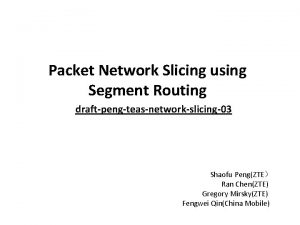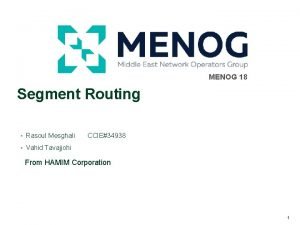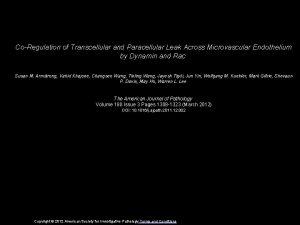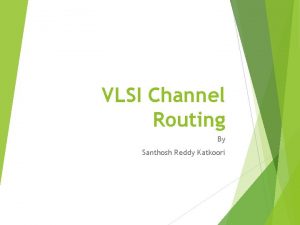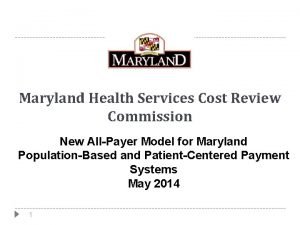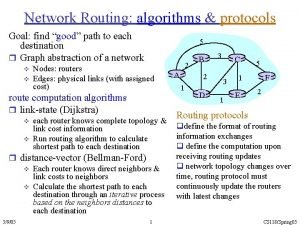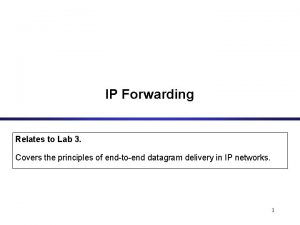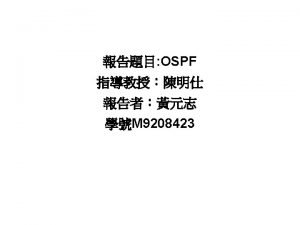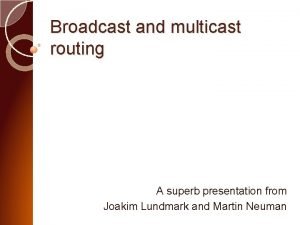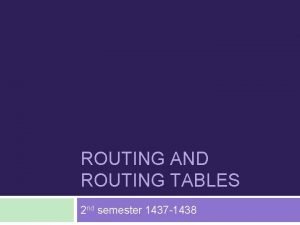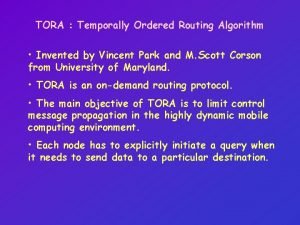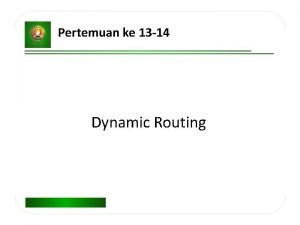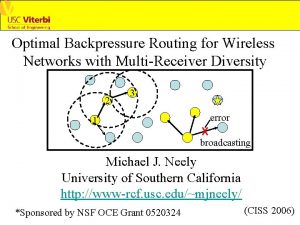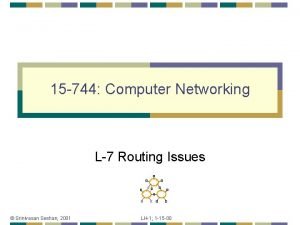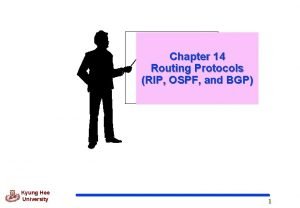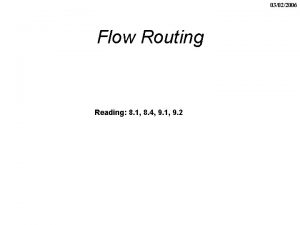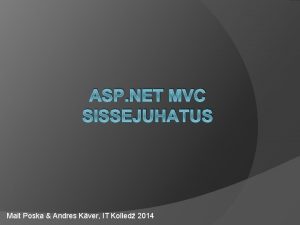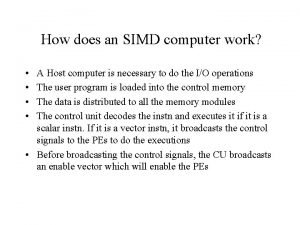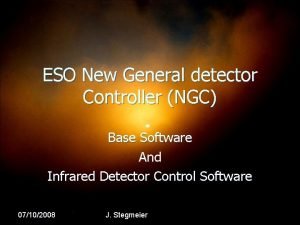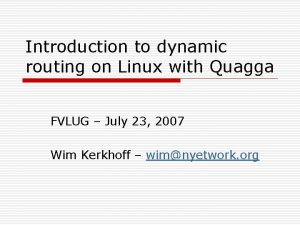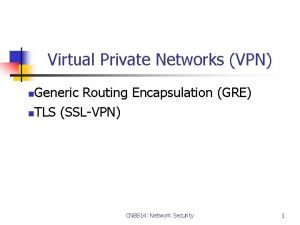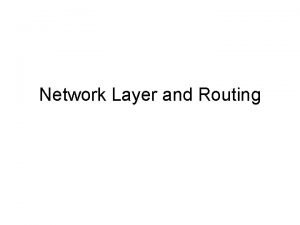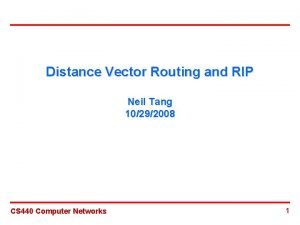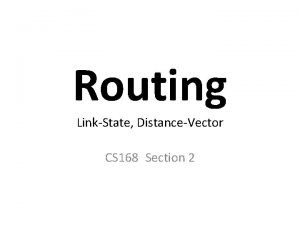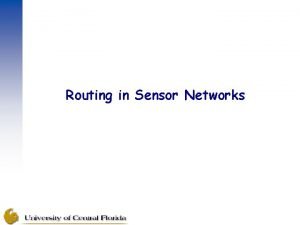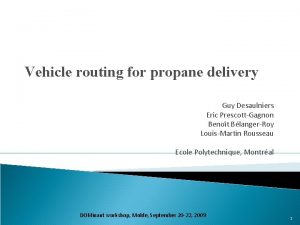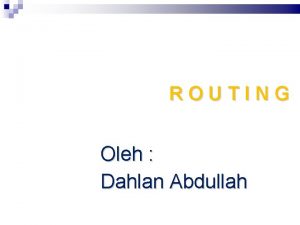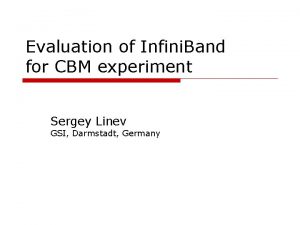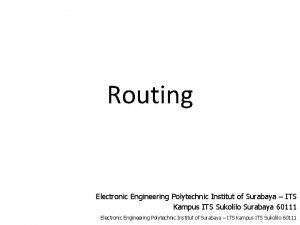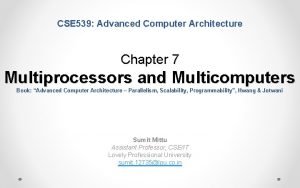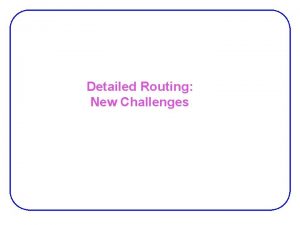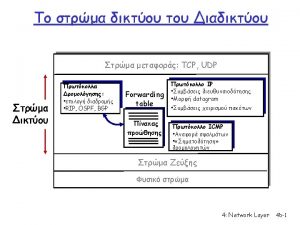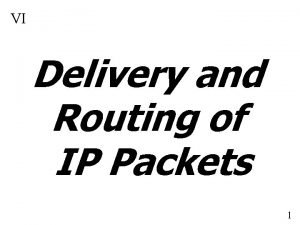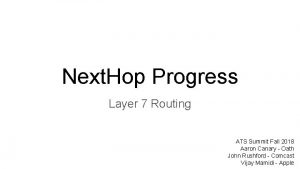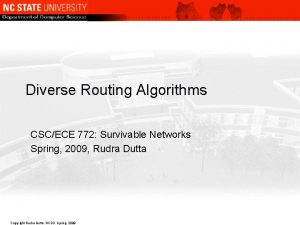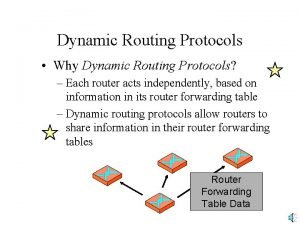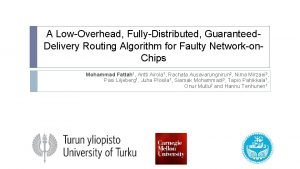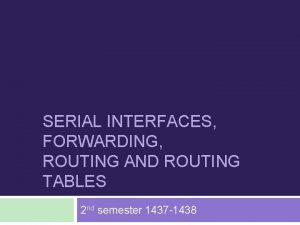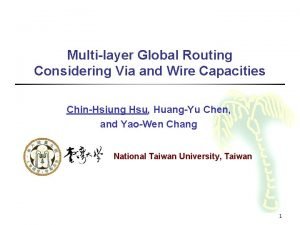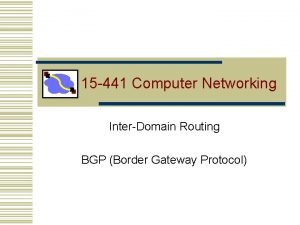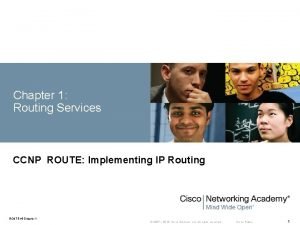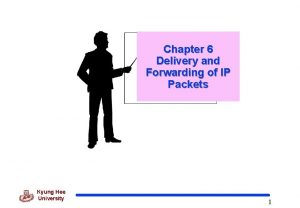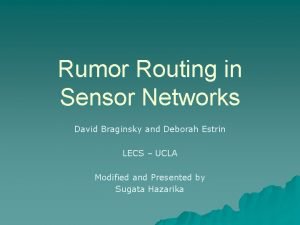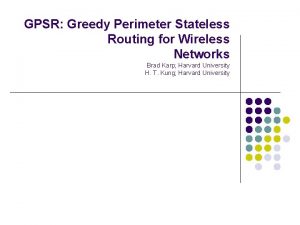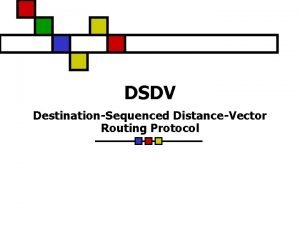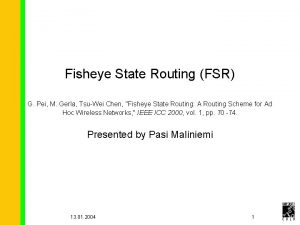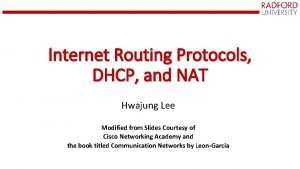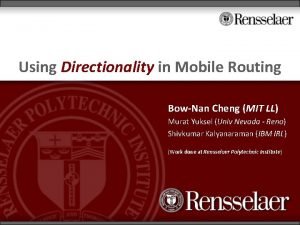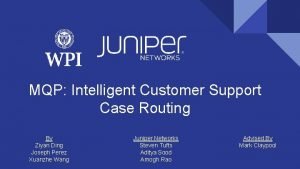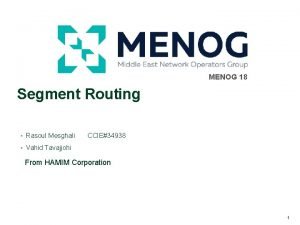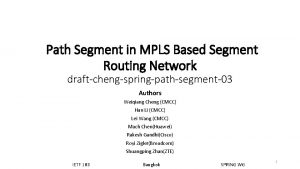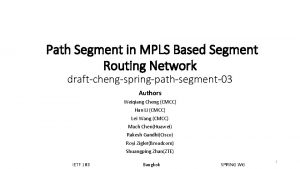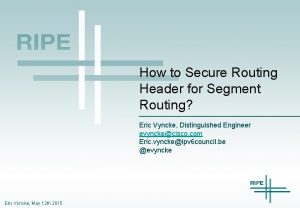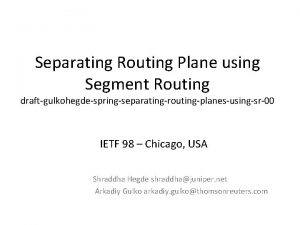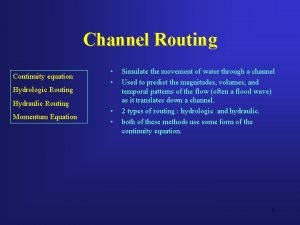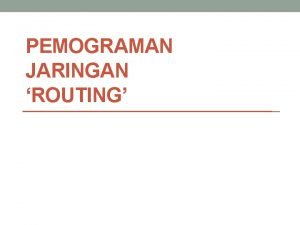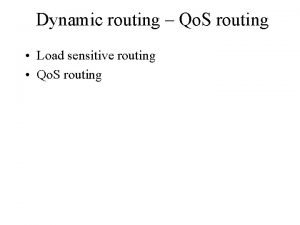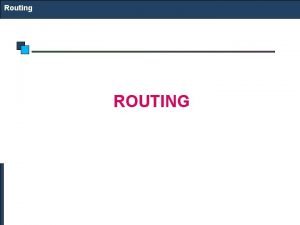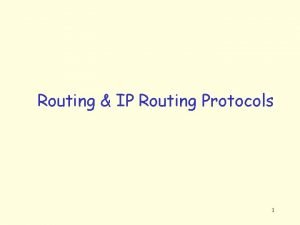MENOG 18 Segment Routing Rasoul Mesghali CCIE34938 Vahid



























































































- Slides: 91

MENOG 18 Segment Routing • Rasoul Mesghali CCIE#34938 • Vahid Tavajjohi From HAMIM Corporation 1

Agenda • Introduction • Technology Overview • Use Cases • Closer look at the Control and Data Plane • Traffic Protection • Traffic engineering • SRv 6 2

MENOG 18 Introduction 3

MPLS Historical Perspective MPLS “classic” (LDP and RSVP-TE) control-plane was too complex and lacked scalability. LDP is redundant to the IGP and that it is better to distribute labels bound to IGP signaled prefixes in the IGP itself rather than using an independent protocol (LDP) to do it. LDP-IGP synchronization issue, RFC 5443, RFC 6138 Overall, we would estimate that 10% of the SP market and likely 0% of the Enterprise market have used RSVP-TE and that among these deployments, the vast majority did it for FRR reasons. The point is to look at traditional technology(LDP/RSVP_TE) applicability in IP networks in 2018. Does it fit the needs of modern IP networks? 4

MPLS Historical Perspective In RSVP-TE and the classic MPLS TE The objective was to create circuits whose state would be signaled hop-by-hop along the circuit path. Bandwidth would be booked hop-by-hop. Each hop’s state would be updated. The available bandwidth of each link would be flooded throughout the domain using IGP to enable distributed TE computation. First, RSVP-TE is not ECMP-friendly. Second, to accurately book the used bandwidth, RSVP-TE requires all the IP traffic to run within so-called “RSVP-TE tunnels”. This leads to much complexity and lack of scale in practice. 5

1. network has enough capacity to accommodate without congestion traffic engineering to avoid congestion is not needed. It seems obvious to write it but as we will see further, this is not the case for an RSVP-TE network. 2. In the rare cases where the traffic is larger than expected or a nonexpected failure occurs , congestion occurs and a traffic engineering solution may be needed. We write “may”because it depends on the capacity planning process. 3. Some other operators may not tolerate even these rare congestions and then require a tactical traffic-engineering process. A tactical traffic-engineering solution is a solution that is used only when needed. 6

An analogy would be that one needs to wear his raincoat and boots every day while it rains only a few days a year. N 2*K tunnels no traffic engineering is required the classic RSVPWhile TE solution is an “always-on” solution in the most complexity limited scale, of. MPLS likely situation offor anthe IPand network, the classical TE solution This is the reason infamous full-mesh RSVP-TE tunnels. always requires all the IP traffic to not beany switched most of time, without gain as IP, but as MPLS TE circuits. 7

Goals and Requirements • Make things easier for operators Improve scale, simplify operations Minimize introduction complexity/disruption • Enhance service offering potential through programmability • Leverage the efficient MPLS dataplane that we have today Push, swap, pop Maintain existing label structure • Leverage all the services supported over MPLS Explicit routing, FRR, VPNv 4/6, VPLS, L 2 VPN, etc • IPv 6 dataplane a must, and should share parity with MPLS 8

Operators Ask For Drastic LDP/RSVP Improvement • Simplicity less protocols to operate less protocol interactions to troubleshoot avoid directed LDP sessions between core routers deliver automated FRR for any topology • Scale avoid millions of labels in LDP database avoid millions of TE LSP’s in the network avoid millions of tunnels to configure 9

Operators Ask For A Network Model Optimized For Application Interaction • Applications must be able to interact with the network cloud based delivery internet of everything • Programmatic interfaces and Orchestration Necessary but not sufficient • The network must respond to application interaction Rapidly-changing application requirements Virtualization Guaranteed SLA and Network Efficiency 10

Segment Routing • Simple to deploy and operate Leverage MPLS services & hardware straightforward ISIS/OSPF extension to distribute labels LDP/RSVP not required • Provide for optimum scalability, resiliency and virtualization • SDN enabled simple network, highly programmable highly responsive 11

MENOG 18 Technology Overview 12

What is the meaning of Segment Routing? Segment 1 10 20 CE 1 P 2 10 10 P 5 P 3 P 4 Segment 2 P 6 P 7 PE 2 CE 2 Segment 3 Default Cost is 100 13

SR in one Slide 24001 Adj-SID Label 16007 Prefix-SID Label Service: L 3 VPN, L 2 VPN, 6 PE, 6 VPE 16099 CE 1 PE 1 24001 16007 P 1 Prefix-SIDs are global Labels Adj-SIDs are local labels P 2 Adj Label 24001 Segment 1 24001 P 5 Prefix-SID Loopback 0 Label 16099 P 4 P 3 Segment 2 16007 P 6 Segment 3 Deviate from shortest path-Source Routing: Traffic Engineering based on SR Prefix-SID Loopback 0 Label 16007 PE 2 P 7 16007 CE 2 PE 2 Default: PHP at each segment 14

Let’s take a closer look 15

• Source Routing the source chooses a path and encodes it in the packet header as an ordered list of segments • the rest of the network executes the encoded instructions (In Stack of labels/IPv 6 EH) • Segment: an identifier for any type of instruction • forwarding or service • Forwarding state (segment) is established by IGP LDP and RSVP-TE are not required Agnostic to forwarding data plane: IPv 6 or MPLS • MPLS Data plane is leveraged without any modification push, swap and pop: all that we need segment = label 16

Segment Routing – Overview • MPLS: an ordered list of segments is represented as a stack of labels • IPv 6: an ordered list of segments is encoded in a routing extension header • This presentation: MPLS data plane Segment → Label Basic building blocks distributed by the IGP or BGP Control Plane Routing protocols with extensions (IS-IS, OSPF, BGP) SDN controller Data Plane MPLS (segment ID = label) IPv 6 (segment ID = V 6 address) Paths options Dynamic (SPT computation) Explicit (expressed in the packet) Strict or loose path 17

Global and Local Segments • Global Segment Any node in SR domain understands associated instruction Each node in SR domain installs the associated instruction in its forwarding table MPLS: global label value in Segment Routing Global Block (SRGB) • Local Segment Only originating node understands associated instruction MPLS: locally allocated label 18

Global Segments – Global Label Indexes • Global Segments always distributed as a label range (SRGB) + Index must be unique in Segment Routing Domain • Best practice: same SRGB on all nodes “Global model”, requested by all operators Global Segments are global label values, simplifying network operations Default SRGB: 16, 000 – 23, 999 Other vendors also use this label range 19

Types of Segment 20

IGP Segment Two Basic building blocks distributed by IGP: -Prefix Segment -Adjacency Segment Prefix-SID (Node-SID) Segment 1 Segment 2 Segment 3 Segment 1 Segment 4 Adjacency-SID Segment 21

IGP Prefix Segment Node-SID 1 5 16006 • Shortest-path to the IGP prefix Equal Cost Multipath (ECMP)aware 16006 2 6 • Global Segment • Label = 16000 + Index 16006 1. 1. 1. 6/32 Advertised as index • Distributed by ISIS/OSPF 7 16005 1 5 16005 1. 1. 1. 5/32 16005 Default SRGB 16000 -23, 999 16005 2 7 16005 6 22

Node Segment FEC Z swap 16065 to 16065 push 16065 to 16065 A B C pop 16065 D E 16065 A packet injected anywhere with top label 16065 will reach E via shortest-path • E advertises its node segment Simple ISIS/OSPF sub-TLV extension • All remote nodes install the node segment to E in the MPLS Data Plane 23

Node Segment FEC Z swap 16065 to 16065 push 16065 to 16065 A Packet to E C B pop 16065 D 16065 Packet to E E 16065 Packet to E A packet injected anywhere with top label 16065 will reach E via shortest-path • E advertises its node segment simple ISIS sub-TLV extension and OSPF • All remote nodes install the node segment to E in the MPLS dataplane 24

Adjacency Segment Adj to 7 1 5 Adj to 6 7 24056 2 24057 6 A packet injected at node 5 with label 24056 is forced through datalink 5 -6 • C allocates a local label and forward on the IGP adjacency • C advertises the adjacency label Distributed by OSPF/ISIS simple sub-TLV extension (https: //datatracker. ietf. org/doc/draft-ietf-isis-segment-routing-extensions/) https: //www. iana. org/assignments/isis-tlv-codepoints. xhtml • C is the only node to install the adjacency segment in MPLS dataplane 25

Datalink and Bundle Pop 9003 9001 switches on blue member Pop 9001 A B Pop 9002 Pop 9003 9002 switches on green member 9003 load-balances on any member of the adj • Adjacency segment represents a specific datalink to an adjacent node • Adjacency segment represents a set of datalinks to the adjacent node 26

A path with Adjacency Segments 9105 9107 9101 9103 9105 9107 9103 9101 1 3 9105 5 9107 7 7 4 2 9103 6 9105 • Source routing along any explicit path stack of adjacency labels • SR provides for entire path control 27

Combining Segments Prefix-SID Adj-SID • Steer traffic on any path through the network • Path is specified by list of segments in packet header, a stack of labels • No path is signaled • No per-flow state is created • For IGP – single protocol, for BGP – AF LS 16007 24078 16011 Packet to Z 16007 1 16007 5 9 7 24078 3 6 8 11 10 16011 Packet to Z 28

Labeling Which prefixes? GE 0/0/0/0 P 1 P 2 P 3 Prefix attached to P 4 10. 20. 34. 0/24 Outgoing label in CEF? Entry in LFIB? Prefix-SID P 4 (10. 100. 1. 4/32) Y Prefix-SID P 4 without Node flag (10. 100. 3. 4/32) Y loopback prefix without prefix-sid (10. 100. 4. 4/32) N link prefix connected to P 4 (10. 1. 45. 0/24) N • So, this is the equivalent of LDP label prefix filtering: only assigning/advertising labels to /32 prefixes (loopback prefixes, used by service, (e. g. L 3 VPN), so BGP next hop IP addresses) • Traffic to link prefixes is not labeled! 29

Data 7 Data R 1 SID: 1 46 Explicit loose path for low latency app 4 7 Dynamic path R 5 SID: 5 R 3 SID: 3 Explicit path R 7 SID: 7 High cost Low latency R 2 SID: 2 R 4 SID: 4 Adj SID: 46 R 6 SID: Segment ID No LDP, no RSVP-TE 30

Any-Cast SID for Node Redundancy • A group of Nodes share the same SID • Work as a “Single” router, single Label • Same Prefix advertised by multiple nodes • traffic forwarded to one of Anycast. Prefix-SID based on best IGP Path • if primary node fails, traffic is auto rerouted to other node 200 70 Packet 10 • Application – ABR Protection – Seamless MPLS – ASBR inter-AS protection 200 70 70 Packet Anycast SID: 200 Packet 200 70 Packet 30 40 70 90 20 50 60 80 31

Binding-SID BSID: 30410 1 2 3 4 10 SID: 30710 5 4 16003 1 4 All Nodes SRGB [16000 -23999] Prefix-SID Node. X: 1600 X Binding-SID X->Y: 300 XY 6 7 9 8 10 16006 16004 30410 Node 10 16007 30410 30710 16010 Node 10 Node 10 16009 Node 10 Binding-SIDs can be used in the following cases: • • • Multi-Domain (inter-domain, inter-autonomous system) Large-Scale within a single domain Label stack compression BGP SR-TE Dynamic Stitching SR-TE Polices Using Binding SID 32

BGP Prefix Segment • Shortest-Path to the BGP Prefix • Global • 16000 + Index Node SID: 16001 12 10 • Signaled by BGP 1 13 3 11 14 BGP-Connections 33

BGP Peering Segment Egress Peering Engineering 16001 30012 BGP-Peering-SID 18005 30012 Packet 18005 Packet 12 10 BGP-Peering-SID SID: 30012 Node SID: 16001 1 Packet 2 13 5 3 11 7 5. 5/32 Node SID: 18005 14 AS 1 • Pop and Forward to the BGP Peer • Local • Signaled by BGP-LS (Topology Information) to the controller • Local Segment- Like an adjacency SID external to the IGP Dynamically allocated but persistent AS 2 34

WAN Controller SR PCE Collects via BGP-LS • IGP Segments • BGP Segments • Topology SR PCE BGP-LS Collects information from network BGP-LS 12 10 1 2 13 5 3 7 5. 5/32 Node SID: 18005 11 14 IGP-1 IGP-2 35

An end-to-end path as a list of segment • Controller learn the SR PCEP, Netconf, BGP network topology and usage dynamically • Controller calculate the optimized path for different applications: low latency, or high bandwidth • Controller just program a list of the labels on the source routers. The rest of the network is not aware: no signaling, no state information simple and Scalable 12 {16001, 16002, 124, 147} 10 Node SID: 16001 1 {16002, 124, 147} 13 Node SID: 16002 Adj SID: 124 4 2 50 Low latency {147} Low bandwidth {124, 147} Peering SID: 147 7 3 11 5 High latency High bandwidth 14 IGP-1 IGP-2 BGP-Peer Default ISIS cost metric: 10 36

37

MENOG 18 Segment Routing Global Block 38

Segment Routing Global Block (SRGB) • Segment Routing Global Block Range of labels reserved for Segment Routing Global Segments Default SRGB is 16, 000 – 23, 999 • A prefix-SID is advertised as a domain-wide unique index • The Prefix-SID index points to a unique label within the SRGB Index is zero based, i. e. first index = 0 Label = Prefix-SID index + SRGB base E. g. Prefix 1. 1. 1. 65/32 with prefix-SID index 65 gets label 16065 index 65 --> SID is 16000 + 65 =16065 • Multiple IGP instances can use the same SRGB or use different non-overlapping SRGBs 39

1 2 3 4 Recommended SRGB allocation: Same SRGB for all 16000 16004 16000 Idx 4 16004 23999 24000 16000 Idx 4 Same SRGB for all: Simple 23999 Predictable 24000 easier to troubleshoot 24004 Idx 4 simplifies SDN Programming 31999 1048575 SRGB 16000 -2399 1048575 SRGB 24000 -31999 40

MENOG 18 Segment Routing IGP Control and Date Plane 41

MPLS Control and Forwarding Operation with Segment Routing Services PE-1 MP-BGP PE-2 IPv 4 IPv 6 IPv 4 VPN IPv 6 VPN VPWS VPLS Packet Transport LDP RSVP BGP Static IS-IS IGP PE-1 PE-2 MPLS Forwarding OSPF No changes to control or forwarding plane IGP label distribution for IPv 4 and IPv 6. Forwarding plane remains the same 42

SR IS-IS Control Plane overview • IPv 4 and IPv 6 control plane • Level 1, level 2 and multi-level routing • Prefix Segment ID (Prefix-SID) for host prefixes on loopback interfaces • Adjacency SIDs for adjacencies • Prefix-to-SID mapping advertisements (mapping server) • MPLS penultimate hop popping (PHP) and explicit-null label signaling 43

ISIS TLV Extensions • SR for IS-IS introduces support for the following (sub-)TLVs: – SR Capability sub-TLV (2) IS-IS Router Capability TLV (242) – Prefix-SID sub-TLV (3) Extended IP reachability TLV (135) – Prefix-SID sub-TLV (3) IPv 6 IP reachability TLV (236) – Prefix-SID sub-TLV (3) Multitopology IPv 6 IP reachability TLV (237) – Prefix-SID sub-TLV (3) SID/Label Binding TLV (149) – Adjacency-SID sub-TLV (31) Extended IS Reachability TLV (22) – LAN-Adjacency-SID sub-TLV (32) Extended IS Reachability TLV (22) – Adjacency-SID sub-TLV (31) Multitopology IS Reachability TLV (222) – LAN-Adjacency-SID sub-TLV (32) Multitopology IS Reachability TLV (222) – SID/Label Binding TLV (149) • Implementation based on draft-ietf-isis-segment-routing-extensions 44

SR OSPF Control Plane overview SR OSPF Control Plane Overview • OSPFv 2 control plane • Multi-area • IPv 4 Prefix Segment ID (Prefix-SID) for host prefixes on loopback interfaces • Adjacency SIDs for adjacencies • MPLS penultimate hop popping (PHP) and explicit-null label signaling 45

OSPF Extensions • OSPF adds to the Router Information Opaque LSA (type 4): – SR-Algorithm TLV (8) – SID/Label Range TLV (9) • OSPF defines new Opaque LSAs to advertise the SIDs – OSPFv 2 Extended Prefix Opaque LSA (type 7) >OSPFv 2 Extended Prefix TLV (1) • Prefix SID Sub-TLV (2) – OSPFv 2 Extended Link Opaque LSA (type 8) >OSPFv 2 Extended Link TLV (1) • Adj-SID Sub-TLV (2) • LAN Adj-SID Sub-TLV (3) • Implementation is based on – draft-ietf-ospf-prefix-link-attr and draft-ietf-ospf-segment-routingextensions 46

TLV 22 TLV 135 47

TLV 242 48

TLV 135 Sub-TLV 3 Prefix-SID SID-Index 16 49

TLV 22 Sub-TLV 32 LAN-Adj-SID 24001 50

MENOG 18 Use Cases 51

Unified MPLS Provisioning EPN 5. 0 Metro Fabric Netconf Yang PCE Programmability L 2/L 3 VPN Services Intra-Domain CP FRR or TE Intra-Domain CP LDP BGP BGP-LU RSVP LDP BGP IGP With SR IGP Do More With Less 52

IPv 4/v 6 VPN/Service transport 5 5 7 7 VPN Packet to Z 5 7 VPN Packet to Z Site-1 VPN 3 2 PE-1 VPN Packet to Z 5 4 5 • No LDP, No RSVP-TE 6 7 7 7 VPN VPN Packet to Z Site-2 VPN 7 7 5 • IGP only PE-7 PHP 5 Packet to Z • ECMP multi-hop shortest-path 53

MENOG 18 Internetworking With LDP 54

Simplest Migration: LDP to SR Initial state: All nodes run LDP, not SR Step 1: All nodes are upgraded to SR • in no particular order • Default label imposition preference = LDP • Leave default LDP label imposition segment-routing mpls sr-preference LDP SR LDP+SR 3 4 LDP SR LDP+SR 1 Step 2: All PEs are configured to prefer SR Label imposition • in no particular order Step 3: LDP is removed from the nodes in the network • in no particular order Final State: All nodes run SR, Not LDP+SR LDP SR SR LDP 2 6 5 LDP SR LDP+SR LDP Domain 55

1 2 4 3 5 segment-routing mpls sr-prefer Local/in lbl Out lbl SRGB 16000 16005 Local/in lbl Out lbl 16000 24005 16005 23999 24000 24001 24002 24001 pop 32011 24005 16005 24003 pop 31999 32011 segment-routing mpls (defualt) 1048575 24003 1048575 56

LDP/SR Interworking - LDP to SR • When a node is LDP capable but its next-hop along the SPT to the destination is not LDP capable • no LDP outgoing label • In this case, the LDP LSP is connected to the prefix segment • C installs the following LDP-to-SR FIB entry: • incoming label: label bound by LDP for FEC Z • outgoing label: prefix segment bound to Z • outgoing interface: D SR LDP • This entry is derived and installed automatically , no config required A B Prefix Z C Out Label (LDP), Interface Input label(LDP) 16, 0 32 D Z Out Label (SID), Interface 16006, 1 57

1. 1. 1. 5/32 lbl 90100 1 1. 1. 1. 5/32 90007 2 4 3 LDP 1. 1. 1. 5/32 5 SR SID 16005 Local/in lbl Out lbl SGB 24000 90008 LDP LSP 90100 Local/in lbl Out lbl 16000 24000 90007 16005 31999 Copy Local/in lbl Out lbl 23999 16005 ? ? 24000 90007 pop 58

LDP/SR Interworking - SR to LDP • When a node is SR capable but its next-hop along the SPT to the destination is not SR capable • no SR outgoing label available • In this case, the prefix segment is connected to the LDP LSP • Any node on the SR/LDP border installs SR-to-LDP FIB entry(ies) SR A Prefix Z B Out Label (SID), Interface ? , 0 LDP C D Input Label(SID) Out Label (LDP), Interface ? 16, 1 Z 16006 59

LDP/SR Interworking - Mapping Server • A wants to send traffic to Z, but • Z is not SR-capable, Z does not advertise any prefix. SID which label does A have to use? • The Mapping Server advertises the SID mappings for the non-SR routers • for example, it advertises that Z is 16066 • A and B install a normal SR prefix segment for 16066 • C realizes that its next hop along the SPT to Z is not SR capable hence C installs an SR-to-LDP FIB entry • incoming label: prefix-SID bound to Z (16066) • outgoing label: LDP binding from D for FEC Z • A sends a frame to Z with a single label: 16006 A Prefix Z SR LDP Z(16006) B Out Label (SID), Interface 16006, 0 C D Input Label(SID) Out Label (LDP), Interface 16006 16, 1 Z 60

Mapping-Server 1. 1. 1. 5/32 lbl 90090 2 1 1. 1. 1. 5/32 Imp-null 5 4 3 SR LDP 1. 1. 1. 5 16000 16005 23999 Local/in lbl Out lbl 16000 16005 Local/in lbl Out lbl pop 16005 NA 90090 23999 Copy Local/in lbl Out lbl 90002 90090 ? 90090 pop 61

MENOG 18 Traffic Protection 62

Classic Per-Prefix LFA – disadvantages • Classic LFA has disadvantages: – Incomplete coverage, topology dependent – Not always providing most optimal backup path Topology Independent LFA (TI-LFA) solves these issues 63

Classic LFA Rules 64

Classic LFA has partial coverage Classic LFA is topology dependent: not all topologies provide LFA for all destinations – Depends on network topology and metrics – E. g. Node 6 is not an LFA for Dest 1 1 (Node 5) on Node 2, packets would loop since Node 6 uses Node 2 to reach Dest 1 (Node 5) Node 2 does not have an LFA for this destination (no backup path in topology) Topology Independent LFA (TI-LFA) provides 100% coverage Dest-1 5 2 6 X 20 3 7 5 Dest-2 Default Metric : 10 Initial Classic LFA FRR TI-LFA FRR Post-Convergence 65

Classic LFA and suboptimal path Classic LFA may provide a suboptimal FRR backup path: – This backup path may not be planned for capacity, e. g. P node 2 would use PE 4 to protect a core link, while a common planning rule is to avoid using 1 Edge nodes for transit traffic – Additional case specific LFA configuration would be needed to avoid selecting undesired backup paths – Operator would prefer to use the postconvergence path as FRR backup path, aligned with the regular IGP convergence TI-LFA uses the post-convergence path as FRR backup path PE-4 Dest-1 100 2 6 X 5 3 7 5 Dest-2 Default Metric : 10 Initial Classic LFA FRR TI-LFA FRR 66 Post-Convergence

TI-LFA – Zero-Segment Example • TI-LFA for link R 1 R 2 on R 1 Prefix-SID Z • Calculate LFA(s) Packet to Z - Compute post-convergence SPT - Encode post-convergence path in a SID-list P-Space - In this example R 1 forwards Prefix-SID Z the packets towards R 5 A Z 1 2 1000 Packet to Z 5 Packet to Z 4 3 Q-Space Default metric: 10 67

TI-LFA – Single-Segment Example • TI-LFA for link R 1 R 2 on R 1 Prefix-SID Z - Compute post-convergence SPTPacket to Z - Encode post-convergence path in a SID-list - In this example R 1 imposes the SID-list <Prefix-SID(R 4)> and Prefix-SID (R 4) Prefix-SID Z sends packets towards R 5 A Z 1 2 Packet to Z P-Space Prefix-SID Z 5 Packet to Z 4 3 Q-Space Default metric: 10 68

TI-LFA – Double-Segment Example Prefix-SID Z Packet to Z TI-LFA for link R 1 R 2 on R 1 - Compute post-convergence SPT - Encode post-convergence path in a SID-list Prefix-SID (R 4) Adj-SID (R 4 -R 3) Prefix-SID Z A Z 1 2 Packet to Z P-Space Prefix-SID Z 5 Packet to Z - In this example R 1 imposes the SIDlist <Prefix-SID(R 4), Adj-SID(R 4 -R 3)> and sends packets towards R 5 4 Adj-SID (R 4 -R 3) Prefix-SID Z 3 1000 Q-Space Default metric: 10 Packet to Z 69

TI-LFA for LDP Traffic LDP (1, Z) Packet to Z A Z 1 2 Packet to Z LDP (5, 4) Adj-SID (R 4 -R 3) Prefix-SID Z P-Space Prefix-SID Z 5 Packet to Z 4 Adj-SID (R 4 -R 3) Prefix-SID Z 3 1000 Q-Space Default metric: 10 Packet to Z 70

MENOG 18 Traffic Engineering 71

RSVP-TE • Little deployment and many issues • Not scalable – Core states in k×n 2 – No inter-domain • Complex configuration – Tunnel interfaces • Complex steering – PBR, autoroute • Does not support ECMP 72

SRTE • Simple, Automated and Scalable – No core state: state in the packet header – No tunnel interface: “SR Policy” – No head-end a-priori configuration: on-demand policy instantiation – No head-end a-priori steering: automated steering • Multi-Domain – SDN Controller for compute – Binding-SID (BSID) for scale • Lots of Functionality – Designed with lead operators along their use-cases • Provides explicit routing • Supports constraint-based routing • Supports centralized admission control • No RSVP-TE to establish LSPs • Uses existing ISIS / OSPF extensions to advertise link attributes • Supports ECMP • Disjoint Path 73

RR SR PCE 1. 10 BGP 1. 1. 1. 3 PCEPBGP-LS 16003 PCC 3 PCEP 1. 1. 1. 2 1. 1. 1. 5 16005 5 BGP 1. 1. 1. 7 16007 PCC VRF Blue 7 PCEP BGP 1. 1. 1. 22 PCC 16022 T: 30 PCEP 22 BGP 1. 1. 1. 21 Domain-2 14 ISI-S/SR Domain-1 13 ISI-S/SR 2 1. 11 11 10 1. 1. 1. 9 16009 9 Router-id of Node. X: 1. 1. 1. X Domain-1 Prefix-SID index of Node. X: X ISI-S/SR Link address XY: 99. X. Y. X/24 with X < Y Adj-SID XY: 240 XY 21 1. 1. 1. 23 PCC 16023 T: 30 23 VRF Blue Default IGP Metric: I: 10 Domain-2 Default TE Metric: T: 10 TE Metric used to express latency ISI-S/SR 74

MAP: PCreq/reply Community (100: 777) means MAP: 1. 1. 1. 21/32 in vrf BLUE must receive COMPUTE: minimize TE Metric to Node 22 “minimize low latency service tag with SR TE Metric” and “compute community RR RESULT : SID list: OIF: to 3 (100: 777) PCE at PCE” VPN Label : 99999 11 10 BGP: 1. 1. 1. 21/32 via 21 BSID: 30022 5 3 2 13 VRF Blue 7 T: 30 22 21 14 9 T: 30 23 VRF Blue Automated Steering uses color extended communities and nexthop to match with the color and end-point of an SR Policy E. g. BGP route 2/8 with nexthop 1. 1 and color 100 will be steered into an SR Policy with color 100 and end-point 1. 1 If no such SR Policy exists, it can be instantiated automatically (ODN) 75

MENOG 18 SRv 6 76

SRv 6 for underlay SRv 6 for Underlay RSVP for FRR/TE Horrendous states scaling in k*N^2 Simplification, FRR, TE, SDN IPv 6 for reach 77

Opportunity for further simplification NSH for NFV UDP+Vx. LAN Overlay SRv 6 for Underlay Additional Protocol and State Additional Protocol just for tenant ID Simplification, FRR, TE, SDN IPv 6 for reach • Multiplicity of protocols and states hinder network economics 78

• IPV 6 Header • Next Header (NH) • Indicate what comes next 79

• NH=IPv 6 • NH=IPv 4 80

• NH=Routing Extension • Generic routing extension header – Defined in RFC 2460 – Next Header: UDP, TCP, IPv 6… – Hdr Ext Len: Any IPv 6 device can skip this header – Segments Left: Ignore extension header if equal to 0 • Routing Type field: > 0 Source Route (deprecated since 2007) > 1 Nimrod (deprecated since 2009) > 2 Mobility (RFC 6275) > 3 RPL Source Route (RFC 6554) > 4 Segment Routing 81

• NH=SRv 6 NH=43, Type=4 82

NH=43 Routing Extension RT = 4 Segment-List 83

MENOG 18 SRH Processing 84

Source Node 2 A 2: : IPv 6 Hdr SA = A 1: : , DA = A 2: : SR Hdr ( A 4: : , A 3: : , A 2: : ) SL=2 3 A 3: : 4 A 4: : IPv 6 Hdr Payload SR Hdr • 1 A 1: : Version Traffic Class Payload Length Flow Label Next = 43 Hop Limit Source Address = A 1: : Destination Address = A 2: : Next Header Len= 6 First = 2 Flags Type = 4 SL = 2 TAG Segment List [ 0 ] = A 4: : Segment List [ 1 ] = A 3: : Segment List [ 2 ] = A 2: : Payload 85

Non-SR Transit Node 1 A 1: : • Plain IPv 6 forwarding IPv 6 Hdr SA = A 1: : , DA = A 2: : SR Hdr ( A 4: : , A 3: : , A 2: : ) SL=2 2 A 2: : 3 A 3: : 4 A 4: : Payload • Solely based on IPv 6 DA • No SRH inspection or update 86

SR Segment Endpoints • SR Endpoints: SR-capable nodes A A 1: : 2 A 2: : whose address is in the IP DA IPv 6 Hdr 3 A 3: : 4 A 4: : SA = A 1: : , DA = A 3: : SR Hdr ( A 4: : , A 3: : , A 2: : ) SL=1 Payload • SR Endpoints inspect the SRH and do: IF Segments Left > 0, THEN Forward according to the new IP DA SR Hdr Update DA with Segment List [ Segments Left ] IPv 6 Hdr Decrement Segments Left ( -1 ) Version Traffic Class Payload Length Flow Label Next = 43 Hop Limit Source Address = A 1: : Destination Address = A 3: : Next Header Len= 6 First = 2 Flags Type = 4 SL = 1 TAG Segment List [ 0 ] = A 4: : Segment List [ 1 ] = A 3: : Segment List [ 2 ] = A 2: : Payload 87

SR Segment Endpoints • SR Endpoints: SR-capable nodes 1 A 1: : 2 A 2: : whose address is in the IP DA 3 A 3: : IPv 6 Hdr 4 A 4: : SA = A 1: : , DA = A 4: : SR Hdr ( A 4: : , A 3: : , A 2: : ) SL=0 Payload • SR Endpoints inspect the SRH and do: IF Segments Left > 0, THEN Update DA with Segment List [ Segments Left ] Forward according to the new IP DA IPv 6 Hdr Decrement Segments Left ( -1 ) Remove the IP and SR header Process the payload: Inner IP: Lookup DA and forward TCP / UDP: Send to socket Standard IPv 6 processing The final destination does not have to be SR-capable. SR Hdr ELSE (Segments Left = 0) Version Traffic Class Payload Length Flow Label Next = 43 Hop Limit Source Address = A 1: : Destination Address = A 4: : Next Header Len= 6 First = 2 Flags Type = 4 SL = 0 TAG Segment List [ 0 ] = A 4: : Segment List [ 1 ] = A 3: : Segment List [ 2 ] = A 2: : Payload … 88

Deployments around the world • Bell in Canada • Orange • Microsoft • Soft. Bank • Alibaba • Vodafone • Comcast • China Unicom 89

Deployments in IRAN • IRAN TIC new Network is going to be implemented based on SR 90

Rasoul Mesghali : rasoul. mesghali@gmail. com Vahid Tavajjohi : vahid. tavajjohi@gmail. com 91
 Power routing in vlsi
Power routing in vlsi Level pool routing example
Level pool routing example Static routing and dynamic routing
Static routing and dynamic routing Continuity equation hydrology
Continuity equation hydrology Segment routing binding sid
Segment routing binding sid Segment routing ipv6
Segment routing ipv6 Segment routing
Segment routing Segment routing ipv6
Segment routing ipv6 Network slicing with segment routing
Network slicing with segment routing Ldp lsp
Ldp lsp Www.pichakgroup.com
Www.pichakgroup.com Better embedded system software
Better embedded system software Steiner bo1
Steiner bo1 Dr vahid khajoee
Dr vahid khajoee Vahid kazemi md
Vahid kazemi md Vahid akhavan
Vahid akhavan Cyrus vahid
Cyrus vahid Vahid tabatabaee
Vahid tabatabaee Vahid hejazi
Vahid hejazi çində vahid dövlətin yaranması
çində vahid dövlətin yaranması Montillation of traxoline
Montillation of traxoline Pada komunikasi satelit, yang termasuk segmen bumi adalah
Pada komunikasi satelit, yang termasuk segmen bumi adalah Segment invasion plan
Segment invasion plan Terminálnet
Terminálnet Route card manufacturing
Route card manufacturing Igrp configuration in packet tracer
Igrp configuration in packet tracer Qbr quality based routing
Qbr quality based routing Routing table
Routing table Eth2r
Eth2r Broadcast routing in computer networks
Broadcast routing in computer networks Bdr
Bdr Broadcast and multicast routing
Broadcast and multicast routing Routing table
Routing table Temporally ordered routing algorithm
Temporally ordered routing algorithm Dynamic routing
Dynamic routing Contoh routing sheet
Contoh routing sheet Call routing in gsm in mobile computing
Call routing in gsm in mobile computing Backpressure routing
Backpressure routing L7 routing
L7 routing Stub link
Stub link Lab - configure router-on-a-stick inter-vlan routing
Lab - configure router-on-a-stick inter-vlan routing 03022006
03022006 Mvc routing
Mvc routing Masking and data routing mechanism
Masking and data routing mechanism Eso charting software
Eso charting software Hydrologic routing
Hydrologic routing Linux dynamic routing
Linux dynamic routing Generic routing encapsulation vpn
Generic routing encapsulation vpn Routing is the responsibility of _______
Routing is the responsibility of _______ Routing table
Routing table Distance vector
Distance vector Cs
Cs Declarative routing
Declarative routing Rumour routing
Rumour routing Hydrologic routing
Hydrologic routing Routing software for propane
Routing software for propane Tabel routing static
Tabel routing static Firstib routing number
Firstib routing number Konfigurasi static routing
Konfigurasi static routing Objectives of routing
Objectives of routing Routing table structure
Routing table structure Matrix capsules with em routing
Matrix capsules with em routing Message routing schemes in computer architecture
Message routing schemes in computer architecture Inter vlan routing challenge
Inter vlan routing challenge Antenna effect in vlsi
Antenna effect in vlsi Interplay between routing and forwarding
Interplay between routing and forwarding Routing table contains information entered manually
Routing table contains information entered manually Arg
Arg 325181028 routing
325181028 routing Diverse routing
Diverse routing Introduction to dynamic routing protocols
Introduction to dynamic routing protocols Ospf routing protocol
Ospf routing protocol Routing switching adalah
Routing switching adalah Delivery routing algorithms
Delivery routing algorithms Cisco cuic
Cisco cuic Routing table
Routing table Rumor routing
Rumor routing Greedy channel routing classified under the type of:
Greedy channel routing classified under the type of: Monotonic routing
Monotonic routing Valley free routing
Valley free routing Bgp administrative distance
Bgp administrative distance Delivery and forwarding of ip packets
Delivery and forwarding of ip packets Rumor routing
Rumor routing Distance-vector routing
Distance-vector routing Routing number cih
Routing number cih Routing protocol
Routing protocol Unececarry
Unececarry Fisheye state routing
Fisheye state routing Dhcp routing protocol
Dhcp routing protocol Morrp
Morrp Intelligent customer routing
Intelligent customer routing Co to jest trasowanie
Co to jest trasowanie








